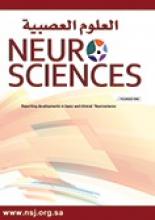Research ArticleOriginal Article
Open Access
Visual evoked potentials follow-up in idiopathic intracranial hypertension
Mehmet Hamamci and Temel Tombul
Neurosciences Journal July 2019, 24 (3) 185-191; DOI: https://doi.org/10.17712/nsj.2019.3.20190004
Mehmet Hamamci
From the Department of Neurology, Faculty of Medicine, Yuzuncu Yil University, Van, Turkey
MDTemel Tombul
From the Department of Neurology, Faculty of Medicine, Yuzuncu Yil University, Van, Turkey
MD
References
- ↵
- McCluskey G,
- Mulholland DA,
- McCarron P,
- McCarron MO
- ↵
- Akçakaya NH,
- Akçakaya MO,
- Sencer A,
- Yapıcı Z
- ↵
- Kilgore KP,
- Lee MS,
- Leavitt JA,
- Mokri B,
- Hodge DO,
- Frank RD,
- et al.
- ↵
- Portelli M,
- Papageorgiou PN
- ↵
- Doubi AO,
- Aljomah DS,
- Alhargan AO,
- Alfawwaz FS
- ↵
- Wall M
- ↵
- Willenborg KD,
- Nacimiento W
- ↵
- Markey KA,
- Mollan SP,
- Jensen RH,
- Sinclair AJ
- ↵
- Razek AAKA,
- Batouty N,
- Fathy W,
- Bassiouny R
- ↵
- Hales CM,
- Fryar CD,
- Carroll MD,
- Freedman DS,
- Ogden CL
- ↵
- Czosnyka Z,
- Czosnyka M
- ↵
- Huang-Link Y,
- Eleftheriou A,
- Yang G,
- Johansson JM,
- Apostolou A,
- Link H,
- et al.
- ↵
- Takkar A,
- Goyal MK,
- Bansal R,
- Lal V
- ↵
- Al Abdulsalam HK,
- Ajlan AM
- ↵
- Bulut MN,
- Oral AY,
- Bulut K
- ↵
- Ilik F,
- Pazarli AC,
- Kayhan F,
- Karamanli H,
- Ozlece HK
- ↵
- Hamzeii-Moghadam A,
- Seifaddini R,
- Hamzei E,
- Khanjani N
- ↵
- Ardissino M,
- Moussa O,
- Tang A,
- Muttoni E,
- Ziprin P,
- Purkayastha S
- ↵
- Zafar A,
- Khatri IA
- ↵
- Arslan D,
- Arıkanoğlu A,
- Akıl E
- ↵
- Wall M,
- Kupersmith MJ,
- Kieburtz KD,
- Corbett JJ,
- Feldon SE,
- Friedman DI,
- et al.
- ↵
- Hainline C,
- Rucker JC,
- Balcer LJ
- ↵
- Almarzouqi SJ,
- Morgan ML,
- Lee AG
- ↵
- Keskin AO,
- Idiman F,
- Kaya D,
- Bircan B
- ↵
- Bidot S,
- Bruce BB,
- Saindane AM,
- Newman NJ,
- Biousse V
- ↵
- Wall M,
- Kupersmith MJ,
- Kieburtz KD,
- Corbett JJ,
- Feldon SE,
- Friedman DI,
- et al.
- ↵
- Smith SV,
- Friedman DI
- ↵
- Gafoor VA,
- Smita B,
- Jose J
- ↵
- El Habashy HR El,
- Gohary AM,
- Azmy RM,
- Hegazy MI,
- Elsanabary ZS,
- Tawfeek AA
In this issue
Visual evoked potentials follow-up in idiopathic intracranial hypertension
Mehmet Hamamci, Temel Tombul
Neurosciences Journal Jul 2019, 24 (3) 185-191; DOI: 10.17712/nsj.2019.3.20190004
Jump to section
Related Articles
- No related articles found.
Cited By...
- No citing articles found.





